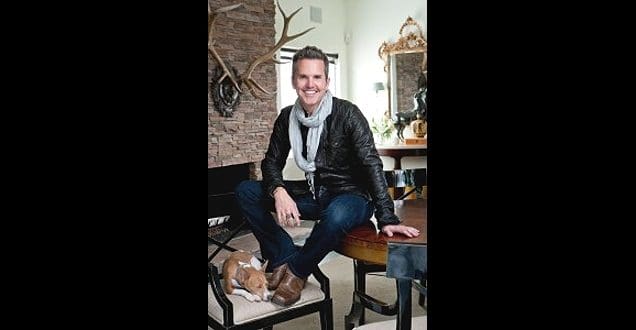Designer Dann Foley has been in Palm Springs over 20 years and has worked in many of our local cities and throughout North America. He is currently on NBC’s American Dream Builders with Nate Berkus. Dann has made it through the first six weeks of competition and the other night, when he was the team lead, his team won their challenge. Elle Decor picked Dann’s Room as their favorite of the week, saying: “The three judges were awed by designer Dann Foley’s creation, with Nate Berkus calling it, ‘universally appealing.’”
Dann Foley just launched multiple new lines of home products, including his outdoor furniture line and line of Loloi rugs called the “Palm Springs” Collection. He is also active with charitable causes in the community.
Kate Buckley: Dann, you are a world-renowned residential and commercial/hospitality designer whose projects are showcased in major cities throughout the U.S. and Canada, as well as parts of Asia, Europe and the Middle East. What brought you to Palm Springs?
Dann Foley: I was born and raised in suburban Philadelphia. Went to college there and started in business there, but I always had my eye on the West Coast (my ideal life was always to live on the West Coast and use that as a base for travel elsewhere). I first expanded to Chicago, then ended up full time on the West Coast about 14 years ago. I went directly to Palm Springs, because I had family there and I already had multiple projects underway for desert clients. It was the easy choice, it didn’t feel like a big decision or hectic move, it just felt like the right move, a natural move.
KB: Are there specific challenges to designing for Palm Springs that don’t exist in say, Chicago or New York?
DF: The obvious answer is of course, designing for intense sun and intense heat. For the interior: There is a definite desire for spaces to be a bit more open, both physically and from a style perspective. A lot of dark colors can be difficult. For instance, I warned teammates on American Dream Builders not to do a black bedroom and bathroom on our recent project in Palm Springs, but they did it any way and everyone turned their noses up at it, because it felt claustrophobic and binding.
There is always the additional question of, how will this product hold up? Also, I do a great deal of landscape and lifestyle design for the outdoors and I am very sensitive to water useage and waste. I don’t allow clients to use inappropriate plantings. I use desert and drought-resistant plantings. BUT, my designs are not arid—my desert landscapes are just as lush as anywhere else in the country I landscape. Let’s just say I’m not a “one boulder and one ocotillo cactus and gravel front yard kind of guy”! I create layered, green, lush, interesting, but very water wise environments. And, I use saline systems and high-efficiency filters for pools, etc.
KB: It all comes down to education. We are in a drought. Southern California is a desert.
DF: Right. And in our valley, landscaping seems to be the last bastion of this old thinking. Tropical plants have NO place in the desert, none. The choice is not only inappropriate, but I go as far as saying, one that people should be ashamed of. They not only are egregiously wasteful, but they also look terrible all summer long. It’s just wrong on all levels.
KB: I like that you are eco-sensitive but don’t sacrifice design in the process. You really CAN have it both ways! And I don’t think a lot of people realize that.
DF: Absolutely! My designs are eco-sensitive, yet still richly appointed, lush and luxurious. I don’t work in a world where you “can’t have that or must do that.” Your choices can be obvious or easy and still be appropriate for the environment and your personal style and needs. These two aren’t mutually exclusive points of view.
KB: So would it be fair to say you endeavor to accurately reflect the desert lifestyle in your Palm Springs-based interior and exterior design?
DF: Yes, all of my valley clients, whether they are full-time or seasonal residents want a sense of place in the desert. They want to feel like their homes are a part of the desert lifestyle. I like to say that I give my clients that with a “twist.” The twist is a sense of their own personalities. I don’t do interiors for anyone that are thematic or formula-based. Uniqueness and personal style are important to me.
KB: I like that you say: “There are no problems, only solutions.” How does this philosophy figure into your design?
DF: People always want to talk about the problems and issues with a house. I encourage them to redirect the conversation. These “issues” frequently become the most interesting aspects of a house. We work with them as much as we can, and they most often become a focal point. We fix it by not ignoring it. Bad design is bad design and comes at every price point, but great design is about solutions, and moving forward. It’s not about overanalyzing every nuance of every room and every house.
KB: How do you think your time on American Dream Builders will influence your ongoing design process and aesthetic—or will it?
DF: In some ways, it definitely already has. I’m known for moving very quickly on my projects. I’d forgotten just how fast fast really is. Unlike other shows, we start at the front curb and work our way back across the property to the back fence. We work with an amazing, experienced crew on every aspect of the project, but it is brutal in regard to time.
Probably the biggest revelation to me, working on the show, was that there are great resources that are available to absolutely everyone, not just the design trade. For instance, the show changed my mind about a major brand, Calico Corners. As they are one of the show’s sponsors, we were only permitted to use fabrics from Calico Corners throughout the show (utilizing their website). It was such an amazing resource, I’m now using it back home in my office. They have absolutely everything I could want from Nate Berkus to Candice Olson to Ralph Lauren, and all styles at all price points. I admit I had a snobbery before about fabric, but that was quickly disabused. I love to be proven wrong. I love to learn something new every day. It makes my life better and my projects more successful.
KB: I love it! The democratization of design.
DF: Absolutely. In fact, when I got home from filming at the end of January, I actually wrote a letter to Calico sharing my story and thanking them for the opportunity and to let them know that we will continue using them. And it was not just stroking their ego, I was so happy about a new resource! And I never use products that I don’t love.
KB: You’ve done so much: styling clients, designing collections, working with clients on their design projects, or doing American Dream Builders. What’s your favorite?
DF: Oh my god. I can honestly say I don’t have one favorite. I get to do what I love every single day, and I love to come to work every day. I have as much fun when we’re styling clients as doing the one-on-one interior design process, or product development, or my time with buyers and retailers, or with one of my licensing partners. To me, design is design and I love it all.
KB: What do you enjoy most about working with your clients to create living environments?
DF: The most exciting part for me is making the design presentation. I’ve taken everything they’ve given me—their wants, needs and desires—but now I’m going to present to them their ideas wrapped in mine in a way they’ve never imagined possible. My job is to expand their vision and I want to knock them on their asses! My presentations can last as long as 8 hours depending on the scale of the project, but at the end I have a rapt audience and boy, they are ready to write that check. And it’s my job to keep them that excited throughout the project. And then of course, there is “the reveal!” I tell every client, if you don’t cry when you walk through the door, then I haven’t done my job. And I can tell you in 27 years that they’ve all cried, and I mean in a good way!
KB: You’ve said, “I love what I do and I work hard—it keeps me out of trouble.” What would you be doing if you weren’t designing?
DF: I often joke that one of the main reasons that I have been successful in my career is my ability to be first, a therapist. I have to listen closely to what people are saying and be able to read between the lines. So, I suppose I would find success as a psychiatrist!
KB: Dann Foley, what do you love most about Palm Springs?
DF: I am what most people would call a health nut. I get up early every morning to workout, and living in Palm Springs affords me the chance to do that outdoors every day. I wake up and run, or jump on my bike to start my day and I get to marvel at the beauty of our mountain ranges and energy that comes from the land here. The Indians have infused this area with such majesty and reverence, and I find that to be palpable. I have said every morning since my first day here, how lucky I am to live in a place of such amazing beauty!






